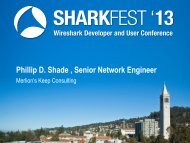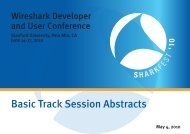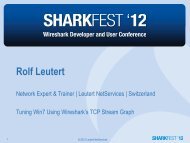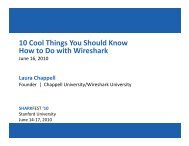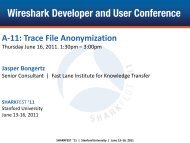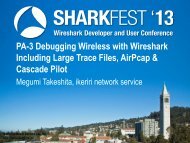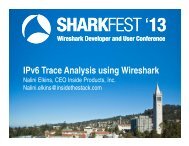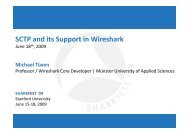IPv6 Addressing - Sharkfest
IPv6 Addressing - Sharkfest
IPv6 Addressing - Sharkfest
You also want an ePaper? Increase the reach of your titles
YUMPU automatically turns print PDFs into web optimized ePapers that Google loves.
<strong>IPv6</strong> <strong>Addressing</strong><br />
Nalini Elkins<br />
CEO<br />
Inside Products, Inc.<br />
Nalini.elkins@insidethestack.com<br />
1
Agenda<br />
• <strong>IPv6</strong> addressing models and types<br />
• unicast,<br />
• multicast,<br />
• anycast,<br />
• global,<br />
• site local,<br />
• link local,<br />
• IPv4 mapped <strong>IPv6</strong>
Let’s Look at Some Addresses<br />
What is this<br />
2601 Warring Street<br />
Berkeley, CA
What if you had to change it to:<br />
XX78:&5;; B78gu E#S<br />
CVTY, MB
Network Addresses<br />
Each one needs one!
What is this<br />
192.168.1.1
What is this<br />
192.168.1.1<br />
•IPv4<br />
•Private
What is this<br />
10.12.15.201
What is this<br />
10.12.15.201<br />
•IPv4<br />
•Private
What is this<br />
201.23.5.104
What is this<br />
201.23.5.104<br />
•IPv4<br />
•Public
Private vs. Public<br />
Public: 2601 Warring Street<br />
Berkeley, CA<br />
Private: P.O. Box 2345,<br />
Berkeley, CA
What is this<br />
FE80:1234::1
What is this<br />
2001::2:ABC:123
What is this<br />
FF01::2
<strong>IPv6</strong> Address Basics<br />
• 128 bits<br />
• Can be zero compressed<br />
• Prefixes are important
<strong>IPv6</strong> Address Representation<br />
• Addresses are shown as 8 sections of 4 hex digits (16 bits) separated<br />
by colons<br />
• 11:22:33:44:55:66:77:88<br />
• For example:<br />
2001:DB8:1:0::2<br />
FE80:208:345:78:123:333::3<br />
2620:345:123:FACE:B00C::3
<strong>IPv6</strong> Prefix<br />
• The prefix length (in bits) can be indicated after a slash at the end.<br />
For example:<br />
• 2001:122:0:0:55:66:77:88 /64<br />
• The prefix above is:<br />
• 2001:122:0:0<br />
• A prefix alone is represented as if the interface ID bits are all zero.<br />
For example:<br />
• 2620:333:ABCD:D0D /64
8<br />
11111111xxxxxxxx.xxxxxxxxxxxxxxxx.<br />
xxxxxxxxxxxxxxxx.xxxxxxxxxxxxxxxx.<br />
xxxxxxxxxxxxxxxx.xxxxxxxxxxxxxxxx.<br />
xxxxxxxxxxxxxxxx.xxxxxxxxxxxxxxxx<br />
00xx::<br />
FFxx::<br />
Important <strong>IPv6</strong><br />
Prefix Notations<br />
/16<br />
1111111111111111.xxxxxxxxxxxxxxxx.<br />
xxxxxxxxxxxxxxxx.xxxxxxxxxxxxxxxx.<br />
xxxxxxxxxxxxxxxx.xxxxxxxxxxxxxxxx.<br />
xxxxxxxxxxxxxxxx.xxxxxxxxxxxxxxxx<br />
0000::<br />
FFFF::<br />
/32<br />
1111111111111111.1111111111111111.<br />
xxxxxxxxxxxxxxxx.xxxxxxxxxxxxxxxx.<br />
xxxxxxxxxxxxxxxx.xxxxxxxxxxxxxxxx.<br />
xxxxxxxxxxxxxxxx.xxxxxxxxxxxxxxxx<br />
0000:0000::<br />
FFFF:FFFF::<br />
/48<br />
/56<br />
/64<br />
1111111111111111.1111111111111111.<br />
1111111111111111.xxxxxxxxxxxxxxxx.<br />
xxxxxxxxxxxxxxxx.xxxxxxxxxxxxxxxx.<br />
xxxxxxxxxxxxxxxx.xxxxxxxxxxxxxxxx<br />
1111111111111111.1111111111111111.<br />
1111111111111111.11111111xxxxxxxx.<br />
xxxxxxxxxxxxxxxx.xxxxxxxxxxxxxxxx.<br />
xxxxxxxxxxxxxxxx.xxxxxxxxxxxxxxxx<br />
1111111111111111.1111111111111111.<br />
1111111111111111.1111111111111111.<br />
xxxxxxxxxxxxxxxx.xxxxxxxxxxxxxxxx.<br />
xxxxxxxxxxxxxxxx.xxxxxxxxxxxxxxxx<br />
0000:0000:0000::<br />
FFFF:FFFF:FFFF::<br />
0000:0000:0000:00xx::<br />
FFFF:FFFF:FFFF:FFxx::<br />
0000:0000:0000:0000::<br />
FFFF:FFFF:FFFF:FFFF::
Zero Compression<br />
• An <strong>IPv6</strong> address can be zero compressed<br />
(saves room!)<br />
• A section of zeros can be replaced by a ::<br />
(double colon).<br />
205B:2D9D:DC28:0:0:FC57:0:0<br />
205B:2D9D:DC28::FC57:0:0<br />
or<br />
205B:2D9D:DC28:0:0:FC57::<br />
• The double-colon can appear only once in<br />
any IP address, because if it appeared<br />
more than once we could not tell how many<br />
zeroes were replaced in each instance.<br />
• So, if our example address were<br />
805B:2D9D:DC28:0:0:FC57:0:0, we could<br />
replace either the first pair of zeroes or the<br />
second, but not both.
Special Addresses<br />
• Zero compression doesn't make our<br />
example much shorter, but due to how <strong>IPv6</strong><br />
addresses are structured, long strings of<br />
zeroes are common.<br />
• It works even better on special addresses.<br />
One special address is: 0:0:0:0:0:0:0:1.<br />
With compression, this is simply ::1<br />
• Consider the <strong>IPv6</strong> address: 0:0:0:0:0:0:0:0.<br />
Apply zero compression to an address that<br />
is all zeroes, and what do you get ::<br />
FF00:4501:0:0:0:0:0:32<br />
FF00:4501::32<br />
0:0:0:0:0:0:0:1<br />
::1<br />
0:0:0:0:0:0:0:0<br />
::
<strong>IPv6</strong> Unicast Address<br />
• This is the address for a specific interface.<br />
• A unicast address has the following format:<br />
There are several types of unicast addresses in <strong>IPv6</strong>:<br />
• global unicast,<br />
• site-local unicast, and<br />
• link-local unicast.
Unicast Address Interface ID<br />
• Interface identifiers in a <strong>IPv6</strong> unicast address are used to identify the<br />
interfaces on a link.<br />
• Interface identifiers are required to be unique on that link.<br />
• The link is generally identified by the subnet prefix.<br />
IID is derived from IEEE identifier (for example: MAC address)
<strong>IPv6</strong> Global Unicast Address<br />
• The <strong>IPv6</strong> global unicast address<br />
is the equivalent of the IPv4<br />
global unicast address.<br />
• Global unicast addresses are<br />
supposed to be used in a<br />
hierarchy.<br />
• This should limit the number of<br />
routing table entries in the global<br />
routing table.
<strong>IPv6</strong> Global Unicast Address<br />
• The global unicast address typically consists of a 48-bit global routing prefix and a 16-bit subnet ID<br />
• The current global unicast address allocation uses the range of addresses that start with binary<br />
value 001 (2000::/3). This is subject to change.<br />
• 2000::/3 is the global unicast address range and uses one-eighth of the total <strong>IPv6</strong> address space. It<br />
is the largest block of assigned block addresses<br />
Global<br />
Routing<br />
Prefix<br />
48 Bits 16 Bits 64 Bits<br />
001…… Subnet ID Interface ID<br />
Global Unicast Address<br />
2001:5c0:8fff:fffe::1<br />
The 16-bit subnet ID<br />
can be used to create<br />
a local addressing<br />
hierarchy and to<br />
identify subnets. This<br />
field allows an<br />
organization to use<br />
up to 65,535<br />
individual subnets.
Interface Identifier<br />
• The 64-bit interface identifier in an <strong>IPv6</strong> address is used to identify a unique interface on a link.<br />
• In many cases, an interface identifier will be the same as or based on the link-layer (MAC)<br />
address of an interface.<br />
• Interface identifiers used in global unicast and other <strong>IPv6</strong> address types must be 64 bits long<br />
and constructed in the EUI-64 format.<br />
• The EUI-64 format interface ID is derived from the 48-bit link-layer (MAC) address by inserting<br />
the hex number FFFE between the upper three bytes (OUI field) and the lower 3 bytes (serial<br />
number) of the link layer address.<br />
Example on Windows PC: result of IPConfig<br />
Ethernet adapter Local Area Connection:<br />
Description : Realtek Family Fast Ethernet NIC<br />
Physical Address : 00-11-D8-39-29-2B<br />
Autoconfiguration Enabled . : Yes<br />
IP Address : fe80::211:d8ff:fe39:292b%4
<strong>IPv6</strong> Prefix Importance<br />
• IPv4 Address : 32 bits<br />
• <strong>IPv6</strong> address : 128 bits<br />
• To start getting familiar with <strong>IPv6</strong><br />
addresses, look at what they start<br />
with.<br />
FE80 = Link Local<br />
FF02 = Multicast<br />
2001 = Global Unicast<br />
0000 = Special<br />
• This will tell you what kind of an<br />
address it is.<br />
• Can you go out on the internet<br />
with it,<br />
• Can you talk to other devices with<br />
it,<br />
• Is it “special”, etc.
<strong>IPv6</strong> Address Types<br />
• Unicast: An address for a single interface. A packet sent to a<br />
unicast address is delivered to the interface identified by that<br />
address.<br />
• Anycast: An address for a set of interfaces. A packet sent to<br />
an anycast address is delivered to one of these interfaces<br />
identified by the address. Many implementations do not<br />
support Anycast.<br />
• Multicast: An address for a set of interfaces (typically<br />
belonging to different nodes). A packet sent to a multicast<br />
address will be delivered to all interfaces identified by that<br />
address.<br />
Anycast address :<br />
2001:5c0:8fff:fffe::3f53<br />
Unicast address :<br />
2001:5c0:8fff:fffe::3f53<br />
Unicast Host<br />
Multicast address :<br />
FF02::1<br />
Anycast Hosts<br />
Multicast Host Group<br />
Anycast addresses appear the same as unicast addresses
More <strong>Addressing</strong> Changes<br />
• Broadcast addressing does not exist in <strong>IPv6</strong>.<br />
• Broadcast functionality is implemented using multicast<br />
addressing to groups of devices. A multicast group to<br />
which all nodes belong can be used for broadcasting in<br />
a network, for example.<br />
• This changes everything!<br />
Broadcast<br />
Addresses<br />
192.168.1.255<br />
255.255.255.255<br />
• The way that address planning is done in IPv4 can no<br />
longer be done!!!<br />
• In IPv4, we designed subnets by having the first<br />
address in the range as a network address and the last<br />
as the broadcast. No more!
<strong>IPv6</strong> Special Unicast Addresses<br />
• Just as in IPv4, a small part of the <strong>IPv6</strong> address space is set aside for special<br />
addresses.<br />
• There are four basic types of "special" <strong>IPv6</strong> addresses:<br />
• Reserved,<br />
• Unspecified,<br />
• Loopback and<br />
• Private
<strong>IPv6</strong> Reserved Unicast Addresses<br />
• A portion of the address space is set aside as reserved<br />
for various uses by the IETF, both present and future.<br />
• Unlike IPv4, which has many small reserved blocks in<br />
various locations in the address space, in <strong>IPv6</strong> the<br />
reserved block is at the “top” of the address space: the<br />
ones starting with “0000 0000” (or 00 for the first<br />
hexadecimal octet).<br />
0000 = Reserved<br />
• This represents 1/256th of the total address space.<br />
• Some of the other special addresses below come from<br />
this block.<br />
• IPv4 address embedding is also done within this<br />
reserved address area.
IPv4 Addresses in <strong>IPv6</strong><br />
• The <strong>IPv6</strong> transition mechanisms use a technique<br />
for tunneling <strong>IPv6</strong> packets over the existing IPv4<br />
infrastructure.<br />
• <strong>IPv6</strong> nodes that support such mechanisms use a<br />
special kind of <strong>IPv6</strong> addresses that carry IPv4<br />
addresses in their lower order 32-bits.<br />
• These addresses are called IPv4 Compatible <strong>IPv6</strong><br />
addresses.<br />
• This is deprecated!<br />
• There is a special type of <strong>IPv6</strong> address that<br />
holds an embedded IPv4 address.<br />
• This address is used to represent the<br />
addresses of IPv4-only nodes as <strong>IPv6</strong><br />
addresses.<br />
• These addresses are used especially by<br />
applications that support both <strong>IPv6</strong> and IPv4.<br />
• These addresses are called IPv4 Mapped <strong>IPv6</strong><br />
Addresses.<br />
0000 = Reserved<br />
80 Bits 16 Bits 32 Bits<br />
0000 = Reserved<br />
80 Bits 16 Bits 32 Bits<br />
zeroes<br />
zeroes<br />
IPv4 Address<br />
zeroes<br />
FFFF<br />
IPv4 Address<br />
IPv4 Compatible <strong>IPv6</strong> Address<br />
::192.168.0.1<br />
IPv4 Embedded <strong>IPv6</strong> Address<br />
::ffff:192.168.0.1
<strong>IPv6</strong> Unspecified Address<br />
• In IPv4, an IP address of all zeroes has a special<br />
meaning - it refers to the host itself, and is used<br />
when a device doesn't know its own address.<br />
• In <strong>IPv6</strong> this concept has been formalized, and the<br />
all-zeroes address (0:0:0:0:0:0:0:0) is named the<br />
unspecified address.<br />
0000 = Unspecified<br />
Who am I IPv4<br />
(BootP, DHCP)<br />
• It is typically used in the source field of a<br />
datagram sent by a device seeking to have its IP<br />
address configured.<br />
• A unicast address is called an unspecified<br />
address if all the bits in the address are zero.<br />
Textually it is represented as "::".<br />
Who am I <strong>IPv6</strong><br />
(Neighbor Solicitation)
164 ADCD PACKET 00000004 08:14:04.416323 Packet Trace<br />
From Interface : ETH1 Device: LCS Ethernet Full=342<br />
Tod Clock : 2006/01/06 08:14:04.416317 Intfx: 4<br />
Sequence # : 0 Flags: Pkt<br />
IpHeader: Version : 4 Header Length: 20<br />
Tos : 00 QOS: Routine Normal Service<br />
Packet Length : 342 ID Number: 0000<br />
Fragment : Offset: 0<br />
TTL : 128 Protocol: UDP CheckSum: 3998 FFFF<br />
Source : 0.0.0.0<br />
Destination : 255.255.255.255<br />
UDP<br />
Source Port : 68 (bootpc) Destination Port: 67 (bootps)<br />
Datagram Length : 322<br />
CheckSum: 93B0 FFFF<br />
BOOTP Opcode : REQUEST HW Type: ETHERNET 10M HW Length: 6<br />
HOP Count : 0 Trans ID: 1047706584 Seconds: 0<br />
Client IP : 0.0.0.0 Your IP: 0.0.0.0<br />
Server IP : 0.0.0.0 Gateway: 0.0.0.0<br />
Client HW Addr : 0013D38D61FB00000000000000000000 Flags: 0<br />
Server Host Name:<br />
Boot FileName :<br />
Vendor Info : 638253633501033D07010013D38D61FB3204C0A801650C0C42617272792D636F<br />
Vendor Info : 6D706171511000000042617272792D636F6D7061712E3C084D53465420352E30<br />
DHCPMSG : DhcpREQUEST<br />
CLIENTID : 7 010013D38D61FB<br />
REQIPADDR : 192.168.1.101
<strong>IPv6</strong> Neighbor Solicitation
Loopback Address<br />
• The loopback address is a reserved<br />
address.<br />
• The address 0:0:0:0:0:0:0:1 is called the<br />
loopback address. It cannot be assigned<br />
to any physical interface. It allows local<br />
applications to send messages to each<br />
other.<br />
• The loopback address cannot be used as<br />
the source address in <strong>IPv6</strong> packets that<br />
are sent outside of a node. An <strong>IPv6</strong><br />
packet with a destination address of<br />
loopback cannot be sent outside of a<br />
node and be forwarded by an <strong>IPv6</strong> router.<br />
• A packet received on an interface with<br />
destination address of loopback will be<br />
dropped.
<strong>IPv6</strong> Private Addresses<br />
• A block of addresses is set aside for private<br />
addresses, just as in IPv4.<br />
• These private addresses are local only to a<br />
particular link or site and are therefore never<br />
routed outside a particular company's network.<br />
• Private addresses are indicated by the<br />
address having "1111 1110 1” for the first nine<br />
bits.<br />
• So, private addresses have a first octet value<br />
of “FE” in hexadecimal, with the next hex digit<br />
being from “8” to “F”.<br />
• These addresses are further divided into two<br />
types based on their scope, described next.<br />
FE8n – FEFn = Private Addresses
Link Local Address<br />
• A link-local unicast address is an <strong>IPv6</strong> unicast address<br />
that is automatically configured on an <strong>IPv6</strong> node<br />
interface by using the link-local prefix FE80::/10 (1111<br />
1110 11) and the interface ID in the EUI-64 format.<br />
Who am I <strong>IPv6</strong><br />
(Neighbor Solicitation)<br />
• Link-local addresses are used in the neighbor discovery<br />
protocol and the stateless autoconfiguration process.<br />
• Link-local addresses are typically used to connect<br />
devices on the same local link network without the need<br />
for global addresses. Hence, link-local addresses are<br />
useful only in the context of the local link network.<br />
FE8n - FEBn = Link Local
Link Local Address<br />
• Nodes on a local link can use link-local addresses<br />
to communicate with each other without the need<br />
for a router.<br />
• <strong>IPv6</strong> nodes do not need site-local or globally unique<br />
addresses to communicate.<br />
• <strong>IPv6</strong> routers must not forward to other links packets<br />
that have link-local source or destination<br />
addresses.<br />
10 Bits 54 Bits 64 Bits<br />
1111111010 zeroes Interface ID<br />
Sample Link Local Address<br />
Fe80:211:d8ff:fe39:292b<br />
• FE80::/10 is the link-local unicast address range<br />
and uses 1/1024 of the <strong>IPv6</strong> address space.<br />
• Let’s look again at the Link Local addresses<br />
generated on the Windows PC.
Site Local Addresses<br />
• Site-local unicast addresses are similar to the<br />
private addresses such as 10.0.0.0/8,<br />
172.16.0.0/12, and 192.168.0.0/16 used in IPv4<br />
networks.<br />
• Routers will not forward any packet with site-local<br />
source or destination address outside the site.<br />
• Site local unicast addresses are deprecated<br />
within <strong>IPv6</strong>(RFC 3879)<br />
FECn - FEFn = Site Local<br />
• Site scope multi-cast still available
<strong>IPv6</strong> Address Space Allocations<br />
<strong>IPv6</strong> Prefix Allocation Reference<br />
----------- ---------- ---------<br />
0000::/8 Reserved by IETF [RFC3513]<br />
0100::/8 Reserved by IETF [RFC3513]<br />
0200::/7 Reserved by IETF [RFC4048]<br />
0400::/6 Reserved by IETF [RFC3513]<br />
0800::/5 Reserved by IETF [RFC3513]<br />
1000::/4 Reserved by IETF [RFC3513]<br />
2000::/3 Global Unicast [RFC3513]<br />
4000::/3 Reserved by IETF [RFC3513]<br />
6000::/3 Reserved by IETF [RFC3513]<br />
8000::/3 Reserved by IETF [RFC3513]<br />
A000::/3 Reserved by IETF [RFC3513]<br />
C000::/3 Reserved by IETF [RFC3513]<br />
E000::/4 Reserved by IETF [RFC3513]<br />
F000::/5 Reserved by IETF [RFC3513]<br />
F800::/6 Reserved by IETF [RFC3513]<br />
FC00::/7 Unique Local Unicast [RFC4193]<br />
FE00::/9 Reserved by IETF [RFC3513]<br />
FE80::/10 Link Local Unicast [RFC3513]<br />
FEC0::/10 Reserved by IETF [RFC3879]<br />
FF00::/8 Multicast [RFC3513]
DeFacto Site Local Unicast Addresses<br />
• Site local unicast addresses are<br />
deprecated within <strong>IPv6</strong>(RFC 3879)<br />
• ULA (Unique Local Unicast) addresses<br />
are being used as site-local.<br />
• Large address space but conflicts<br />
FC00:: /7 = ULA
<strong>IPv6</strong> Multicast<br />
• What is multicasting<br />
• Multicast traffic is sent to a single<br />
address but is processed by multiple<br />
hosts.<br />
• Multicasting is similar to a newsletter<br />
subscription. As only subscribers<br />
receive the newsletter when it is<br />
published, only host computers that<br />
belong to the multicast group receive<br />
and process traffic sent to the<br />
multicast group's address.<br />
• The set of hosts using a specific<br />
multicast address is called a multicast<br />
group.<br />
• In IPv4, Multicast uses:<br />
• Class D IP address: (224.xx.xx.xx –<br />
239.xx.xx.xx)<br />
Unicast address :<br />
2001:5c0:8fff:fffe::3f53<br />
Multicast address :<br />
FF02::1<br />
Multicast Group
<strong>IPv6</strong> Multicast <strong>Addressing</strong><br />
<strong>IPv6</strong> multicast addresses are reserved and assigned from the Format Prefix 1111 1111 (0xFF).<br />
The following is a partial list of <strong>IPv6</strong> multicast addresses that are reserved for <strong>IPv6</strong> multicasting and<br />
registered with the Internet Assigned Numbers Authority (IANA). The address shown below are<br />
multicast for the same link.<br />
<strong>IPv6</strong> multicast address Description<br />
---------------------------------------------------------------------------------<br />
FF02::1 The all-nodes address<br />
FF02::2 The all-routers address<br />
FF02::5 The all-Open Shortest Path First (OSPF) routers address<br />
FF02::6 The all-OSPF designated routers address
Summary<br />
<strong>IPv6</strong> is much more than<br />
a larger address!<br />
Contact: nalini.elkins@insidethestack.com




